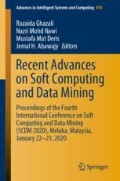Abstract
Detecting complexes in protein interaction networks is one of the most important topics of current computational biology research due to its prominent role in predicting functions of yet uncharacterized proteins and in diseases diagnosis. Evolutionary Algorithms (EAs) have been adopted recently to identify significant protein complexes. Conductance, expansion, normalized cut, modularity, and internal density are some well-known examples of complex detection models. In spite of the improvements and the robustness of predictive functions introduced by complex detection models based on EA and regardless of the general topological properties of protein interaction networks, inherent biological data of protein complexes has not, or rarely exploited and incorporated inside the methods as a specific heuristic operator. The aim of this operator is to guide the search process towards discovering hyper-connected and biologically related complexes by allowing a more effective exploration of the state space of possible solutions. Thus, the main contribution of this study is to develop a heuristic biological operator based on Gene Ontology (GO) annotations where it can serve as a local-common optimization approach. In the experiments, the performance of eight EA-based complex detection models has analyzed when applied on the yeast protein networks that are publicly available. The results give a clear argument for the positive effect of the proposed heuristic biological operator to considerably enhance the reliability of the current state-of-the-art optimization models.
Access this chapter
Tax calculation will be finalised at checkout
Purchases are for personal use only
References
Krogan NJ et al (2006) Global landscape of protein complexes in the yeast Saccharomyces cerevisiae. Nature 440(7084):637
Pizzuti C, Rombo SE (2014) Algorithms and tools for protein–protein interaction networks clustering, with a special focus on population-based stochastic methods. Bioinformatics 30(10):1343–1352
Brohée S, van Helden J (2006) Evaluation of clustering algorithms for protein-protein interaction networks. BMC Bioinform 7(1):488
Bui TN, Jones C (1992) Finding good approximate vertex and edge partitions is NP-hard. Inf Process Lett 42(3):153–159
Elmsallati A, Clark C, Kalita J (2016) Global alignment of protein-protein interaction networks: A survey. IEEE/ACM Trans Comput Biol Bioinform 13(4):689–705
Jancura P, Mavridou E, Carrillo-de Santa Pau E, Marchiori E (2012, June) A methodology for detecting the orthology signal in a PPI network at a functional complex level. In: BMC bioinformatics, vol 13, No 10, p S18. (BioMed Central)
Pizzuti C (2014) Computational intelligence for community detection in complex networks and bio-medical applications. [Sl: Sn]
Arnau V, Mars S, Marín I (2005) Iterative cluster analysis of protein interaction data. Bioinformatics 21(3):364–378
Pei P, Zhang A (2005) A two-step approach for clustering proteins based on protein interaction profile. In: Proceedings of IEEE computational systems bioinformatics conference, CSB, vol 2005, no 1544467, p 201. NIH Public Access
Cho YR, Hwang W, Ramanathan M, Zhang A (2007) Semantic integration to identify overlapping functional modules in protein interaction networks. BMC Bioinformatics 8(1):1
Georgii E, Dietmann S, Uno T, Pagel P, Tsuda K (2009) Enumeration of condition-dependent dense modules in protein interaction networks. Bioinformatics 25(7):933–940
Pizzuti C, Rombo S (2012b) Experimental evaluation of topological-based fitness functions to detect complexes in PPI networks. In: Proceedings of the 14th annual conference on Genetic and evolutionary computation, pp 193–200. ACM
Bandyopadhyay S, Ray S, Mukhopadhyay A, Maulik U (2015) A multiobjective approach for identifying protein complexes and studying their association in multiple disorders. Algorithms Mol Biol 10(1):1
Ramadan E, Naef A, Ahmed M (2016) Protein complexes predictions within protein interaction networks using genetic algorithms. BMC Bioinformatics 17(7):269
Ding C et al (2001) A MinMaxCut spectral method for data clustering and graph partitioning. Proc IEEE Int’l Conf Data Mining 2001:107–114
Bara’a AA, Abdullah QZ (2018) Improving the performance of evolutionary-based complex detection models in protein–protein interaction networks. Soft Comput 1–24
Lancichinetti A, Fortunato S, Kertész J (2009) Detecting the overlapping and hierarchical community structure in complex networks. New J Phys 11(3):033015
Newman ME, Girvan M (2004) Finding and evaluating community structure in networks. Phys Rev E 69(2):026113
Leskovec J, Lang KJ, Mahoney M (2010, April) Empirical comparison of algorithms for network community detection. In: Proceedings of the 19th international conference on World wide web, pp 631–640. ACM
Park Y, Song M (1998, July) A genetic algorithm for clustering problems. In: Proceedings of the third annual conference on genetic programming, pp 568–575
Mewes HW et al (2002) MIPS: a database for genomes and protein sequences. Nuclc Acids Res 30(1):31–34
Gavin AC et al (2006) Proteome survey reveals modularity of the yeast cell machinery. Nature 440(7084):631
Zaki N, Berengueres J, Efimov D (2012) Detection of protein complexes using a protein ranking algorithm. Proteins Struct Funct Bioinform 80(10):2459–2468
Author information
Authors and Affiliations
Corresponding author
Editor information
Editors and Affiliations
Rights and permissions
Copyright information
© 2020 Springer Nature Switzerland AG
About this paper
Cite this paper
Abduljabbar, D.A., Hashim, S.Z.M., Sallehuddin, R. (2020). An Enhanced Evolutionary Algorithm for Detecting Complexes in Protein Interaction Networks with Heuristic Biological Operator. In: Ghazali, R., Nawi, N., Deris, M., Abawajy, J. (eds) Recent Advances on Soft Computing and Data Mining. SCDM 2020. Advances in Intelligent Systems and Computing, vol 978. Springer, Cham. https://doi.org/10.1007/978-3-030-36056-6_32
Download citation
DOI: https://doi.org/10.1007/978-3-030-36056-6_32
Published:
Publisher Name: Springer, Cham
Print ISBN: 978-3-030-36055-9
Online ISBN: 978-3-030-36056-6
eBook Packages: Intelligent Technologies and RoboticsIntelligent Technologies and Robotics (R0)

